Monogram NASCAR 1985 Thunderbird version 1
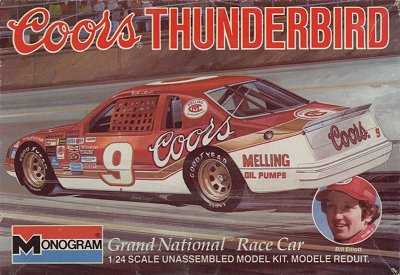
I have two NASCAR models under construction. The oldest is Monogram's 1/24 Ford Thunderbird driven by Bill Elliott in the 1984 and 1985 seasons. The build started easy enough, but I found more and more problems.
During the build process of this model, I slowly learned its problems and their origins. I decided it was better to start anew with two new bodies. Construction was therefore stopped, but I immediately started work on a second model.
|
The kit
I don't know much about the dozens and dozens of stock cars issued by Monogram. I've read they share a lot of parts, which could mean that the detailing is generic, but at the same time most 1:1 cars use the same chassis (Banjo Matthews in this case), suspension and drive train parts. One problem mentioned is that the roll cages don't always fit the various body shapes very well, especially around the A and B pillars. I collected the following comments from the Randy Ayers Nascar forum. All are from before the database got corrupted, so the links are no longer working.
'Eazy': "The kit was cast in late 82 for Stroker Ace, and mirrored the movie car, which wasn't Nascar approved. The 83-86 was wrong wheelbase, front fenders were messed up and ballooned out as well as body lines and air dam." (link)
Tom M.: "That's one of the many issues with the Monogram '83 Thunderbird. The kit was tooled before the race cars were approved by NASCAR and built, the only existing '83 Thunderbird race car was the car Will Cronkrite built from a cut down Banjo chassis for the movie 'Stroker Ace'. Ford provided factory sheet metal and Cronkrite cut down the chassis and massaged the sheet metal to fit the chassis. That car had the wheelbase several inches too short to be legal and was off in other areas too." (link)
Tom M.: "I've been meaning to see how hard it would be to adapt one of the Monogram Thunderbird Pro Stock bodies to a Lumina or roundside Monte Carlo chassis to make something more accurate for an '85-'86 speedway Thunderbird like the Elliott Winston 500 car or the Daytona 500 winner. It has the nose stretched and doesn't have the widened fenders, the speedway cars were narrowed up as much as possible for low frontal area." (link). Note: a build report of the 84 Ford T-Bird Pro Stock on the MCM forum confirms this might be a road worthy of investigating.
Dave Van: "Tom has it right. When Monogram decided to do the Cup kits the project started in 1982. The squarebird was going to be done but Ford said the 83 was all new so do it. Bob Johnson measured the car at Banjo's shop. It's also why the headlight doors are wrong on the kit.. that bugged me more than anything else!!! The door rub strip is another PIA to fix. Still a ground breaking kit." (link)
scatpack: "I have a few of these but haven't done anything with them yet. Just noticing in the pictures how much has to be changed. Then again, Bill Elliott's superspeedway cars practically scraped the ground and had no seams. Almost looked chopped and stretched. Then on the short tracks they seemed to look more like the Monogram model, higher ride height and wheels practically sticking outside the wheel openings (still minus the door seams)." (link)
mchalal: "Somebody not too long ago showed how to correct the front wheel well with sheet plastic. It isn't too hard to do. The more "tedious task" is to smooth out the body removing the door rubber strip molding. I would check in the fab shop section." (link). That was the Dale Earnhardt #15 Wrangler Thunderbird by Jetdoc.
RayH: "Only issues I had with the kit were the wheels, which were wrong for the Elliott and Yarborough cars. The body side molding, which I never could fix, and the engine detail, which was not up to later standards. But for the day, this was a great kit, and the basics ran right throught to the next generation kit of Monogram T-Birds!" (link)
bcs1973: "In addition to the fender mods and seam filling mentioned earlier I would suggest adding putty to the area where the bulge in the front fender meets the door and blend it in. This helps get rid of the sharp transition the kit body has in that area. Also remove the flange that holds the rear quarter window since you won't use that window on an 85. I did that car last year and it took a lot of time but turned out OK. Also fill in the area where the a post meets the door to make it look like your original photo. One last thing: Bill ran a high back seat at the speedway on Banjo chassis. I used an 87 chassis when I built mine for that reason."(link)
odcics2: "If any of you get to the Ford Museum in Dearborn, MI, it's plainly seen that the car has been narrowed."(link)
Dave Van: "Side rub strip on door and rear 1/4 needs to be removed. Front wheel arch needs correction. Headlight buckets need to be reworked. If you want a 100% correct contest models you have to stretch the body.. but never seen it done.. no one ever notices. "(link)
Sea Dog: "No expert, but to my eyes, the headlight doors, the front fender wheel openings the extra trim on the lower body, the side window openings are too larger. The front bumper is wrong.. other than that its perfect "(link)
George Andrews: "The three items that I consider most important to fix on the Monogram 1983 T-Bird: 1) The factory rub strips on the lower body sides have to be removed. Lotsa filing and chisel blade work here. Be sure to leave the small body groove above the rub strip though. 2) Fill in the front fender openings back towards the door panels. 3) Lower the body down onto the chassis more. I have found that the underside of the side window ledges hits the top door bar of the roll cage. You can lower the top door bar a bit, or thin the underside of the window ledge, or simply remove the window ledge entirely and replace it with thin plastic strip. Other body mods to consider would include fixing the flush headlight openings, and filing down the fender bulges for a narrower body look." (link)
George Andrews: "Years ago at a SoCal meeting of IPMS, I was fortunate to talk to Budd Anderson a bit. He claimed to have told Dan & Ernie Elliott how to section a Thunderbird body so it would still pass templates"(link)
pearson4ever: "I tried cutting the front and rear fenders to remove some of the flare out of them. The tires then stuck out of the openings. It was just a poor design by Monogram, the width is way too much in regards to the chassis and suspension to make a good superspeedway car without a lot of modifications." (link)
From the above I compiled the following list of problems:
the wheelbase is too short. I measured the kit's wheelbase, and came up with 114.5 mm, noting that I had done work on both the front and rear suspension, so the measurements might be slightly off. 114.5 mm is 108 inches in 24/1 scale, but 1984 regulations prescribed a 110 inch wheelbase. So that's 2 mm missing in the model. I would say it's missing between the front wheels and the doors, which would lead to an involved modification of the chassis, fenders and hood.
IMPORTANT UPDATE! I initially measured the kit's wheelbase on the right side, and found 114.5 mm. But when I made a dummy front suspension from extra parts, I noted that the front wheels were staggered, by as much as 1.5 mm. And I noticed that the rear axle can be mounted with a millimeter of play. Therefore the good news is that the wheelbase is correct on the left side! The right side requires modification of the track rod to correct the problem. And the chassis does not require a difficult lengthening of 2 millimeters. Hurray!
a big question is whether the model represent a superspeedway version, a short-track or a road track version. This affects a number of aspects, like tyre-fender distance and cooling and brake inlets. I would say it's a short-track version.
the width is in doubt. To build an accurate T-bird as raced by Elliott on superspeedways, you would also need to narrow the model. It is now pretty much established that the team cut some inches from the width, creating an interesting aerodynamic advantage. The team had figured out that Nascar used templates only front to back to check for height, length, spoilers, windshield pitch, etc. No templates were used to measure the width of the car. I've never seen a number for this modification, so it's difficult to portray it in scale. It could be measured on the Ford museum example in Dearborn.
the front wheel opening is too big at the rear. You can see part of the chassis and engine bulkhead, which isn't the case on the real car
the front wheel fender 'balloons' too much, and the fender doesn't connect to the door smoothly but with a kink. If you take out the ballooning, the wheels will stick out. A check of the front and rear track is in order.
the door gaps need to be filled
the rubber molding on the door must be removed. However, I also see some people extending that molding downwards.
the headlights are off, but I'm not sure in what sense
the air dam has some shape problems
the five-hole wheels are not correct. This car had nine-hole wheels
there was no side rear window in 84 and 85, and the recessed lip should be removed
the B-pillar extends further into the car. It should cover the main hoop, but the main hoop is positioned too far aft
the recess in the door for the mirror should be filled, and made a bit smaller.
the lower edge of the cabin section, between the front and rear wheel openings, looks too rounded, and should run more straight down
the window side of the door's A-pillar has a strange angle, and might looks better if sanded to another angle
the door window's lower edge is too narrow, it should extend further into the car
During the build process I also noted that the nose is too 'square' in plan view. The grille should be more forward, creating a more pointed nose. It's an involved body modification however! The distance between the headlight and the front wheel opening is also on the short side, leading to problems with the contingency decals. If you would add 2 mm between the door and the wheel opening for the wheelbase correction, plus the modifications of the nose as just described, the front of the car would become some 4-5 mm longer, 4-5 inches in 1:1 scale. I think you would then finally get the sleek look of the real car.
Apart from some doubts about the accuracy of the kit, I like the kit a lot. It's well detailed and with suitable painting it will look very good. I intend to build the kit as an 'after-race' model, dirty, a little damaged, and with the window net down.
Differences between the 1984 and 1985 cars
Pat Campbell identified the following differences between the years:
the top of the bumper on the '84 car was painted red, where it was painted white on the '85 and '86 cars.
the '84 car, and the 1985 Daytona 500 winner had an all chrome grille. On most of the other 1985 cars, the grille was painted red and had a natural metal screen.
most of the 1984 cars had a red pinstripe just under the gold stripe on the car. The '85 and '86 cars didn't have this stripe.
another difference are the hood decals. Some of the '85 cars, and all of the '86 cars had the large 'Melling Oil Pumps' decals across the hood. The '84 car and some of the '85 cars (the Daytona and Darlington winners) had the small, square 'Melling Oil Pumps' on the LF corner of the hood, with gold 'Rocky Mountain Gold' markings just below the 'Coors' markings on the hood.
A photo link:
Four pictures of Bill Elliott's car during the 1984 season, from 'Racing Yearbook 1985' by Raymond W. Slough, Jr.:
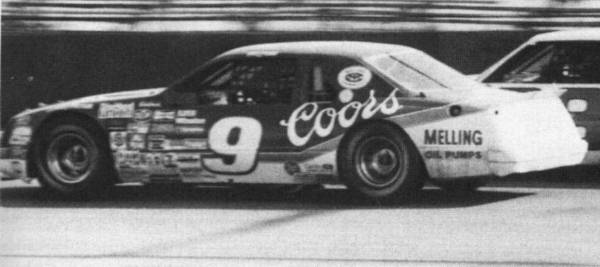
| 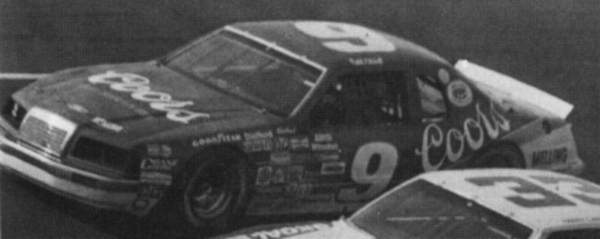
|
| Finishing fourth at the Van Scoy 500 at Long Pond (PA), 9 June 1984
| Elliot wins the Miller 500 at Rockingham (NC) on 21 October 1984.
|
|
|
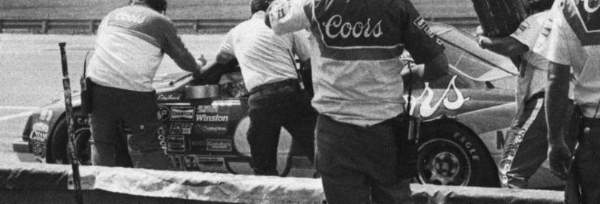
| 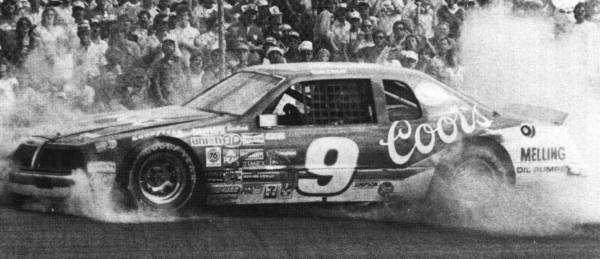
|
| Fuel stop during the Champion Spark Plug 400 at Brooklyn (MI), finishing third (12 August 1984).
| Elliot hits the wall after a puncture during the Wrangler 400 at Richmond (VA), 9 September 1984.
|
Model's origin
| In Thomas Graham's book 'Monogram Models', page 129, I found some background on this model. It partly explains why the model has a lot of shape problems.
| 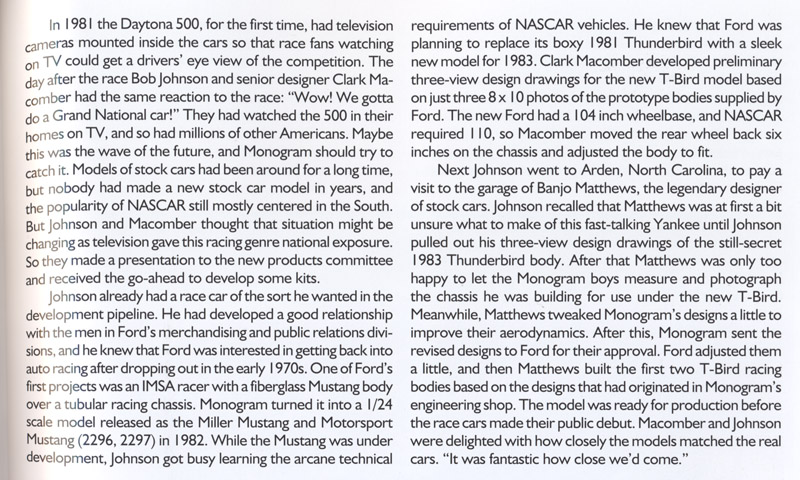
|
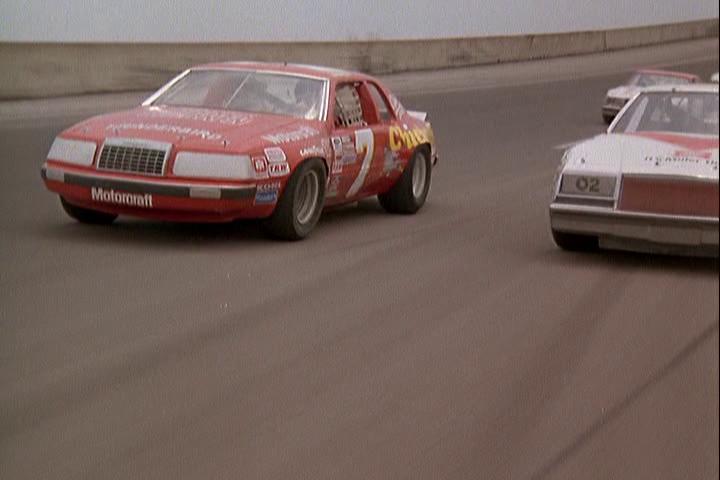
| To illustrate one of the movie cars, here's a screengrab from the movie DVD, probably by Bernie427 who posted a bunch more.
|
The 'plucked chicken' version of the car looks horrible, and possibly has the original 104 inch wheelbase?
In the YouTube video Tales From Behind The Scenes of Stroker Ace, Will Cronkrite tells that two prototype street 1983 T-Birds (out of five produced) were delivered to his shop for the movie. These two were stripped of anything flamable, and given a Nascar look, with a roll cage (possibly non-functional), fatter fenders, wheels etc. They had stock 4-cylinder engines with electronic fuel injection, that was replaced by a carburetor. This suggest that the prototypes were 'Turbo Coupes', the top-of-the-line model fitted with a turbocharged 2.3 L (140 cu in) four-cylinder engine, with Ford's EEC-IV electronic engine control system.
| 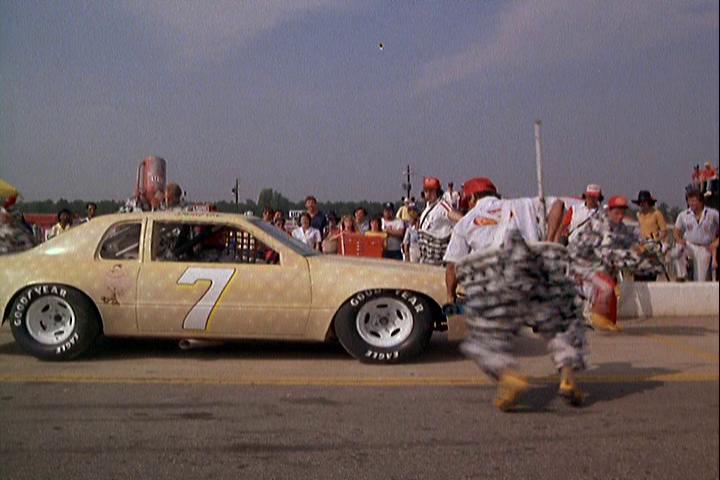
|
Chassis construction
My main focus so far was the chassis. I deviated from the instructions to assemble the chassis as a whole. There was a bad fit interference between the lower window sill of the body and the upper bar of the sides of the roll-cage. I thinned both parts, and achieved a better but not perfect fit. The outboard edges of the floor plate were still 0.5 mm below the edges of the body sides.
Next I removed the window net, to replace it later with a more realistic one that can be draped over the side of the car. Roll bar padding has to be added too. I painted the chassis Humbrol 128, trying to replicate the color that I saw in photos. I've given the whole chassis a wash and a slight drybrush job, which makes it much more realistic.
| 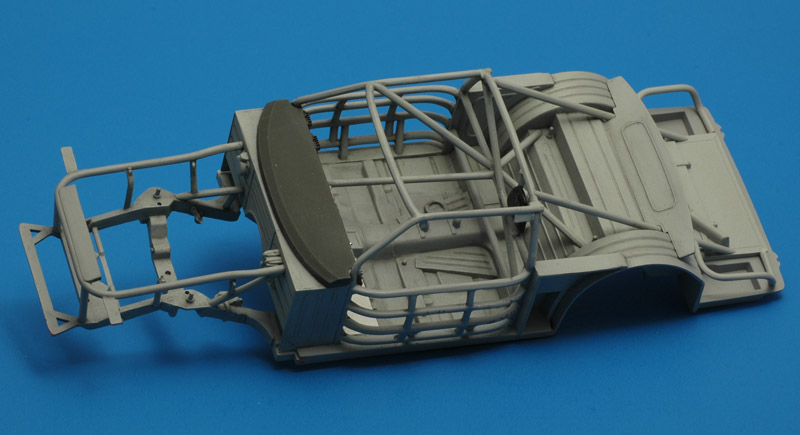
|
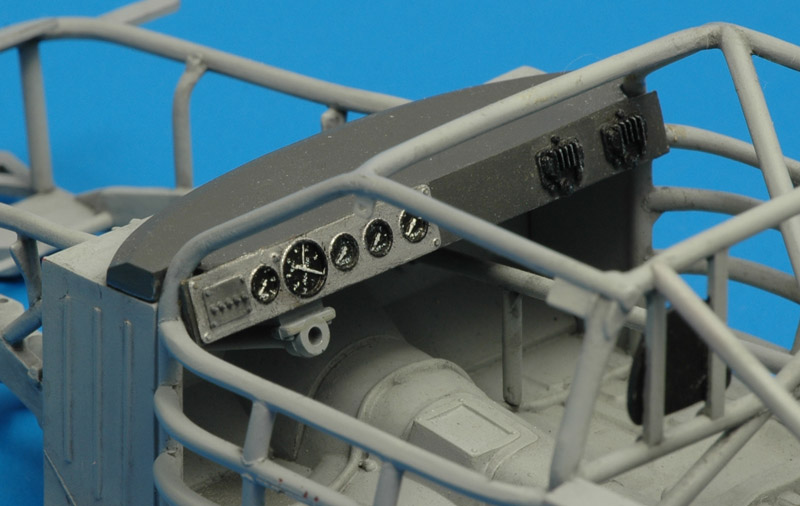
| Instead of using black for the dashboard, I used Humbrol 67 dark gray. I painted the instrument panel Humbrol Polished Aluminium. The instruments were black with silver bezels and white drybrushed lettering. The ignition boxes were painted satin black.
|
| I tried my best to make the chassis / roll cage look like one piece. I still need to do some detail painting in the engine bay, like the steering box.
| 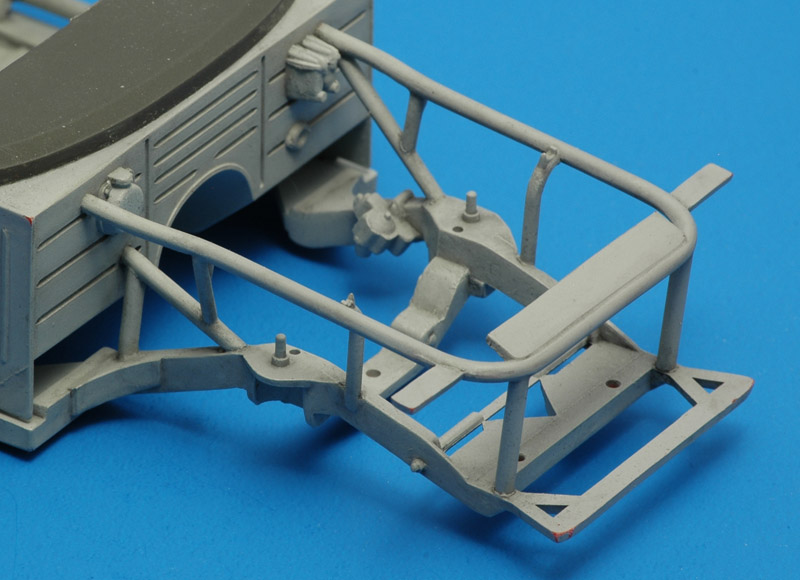
|
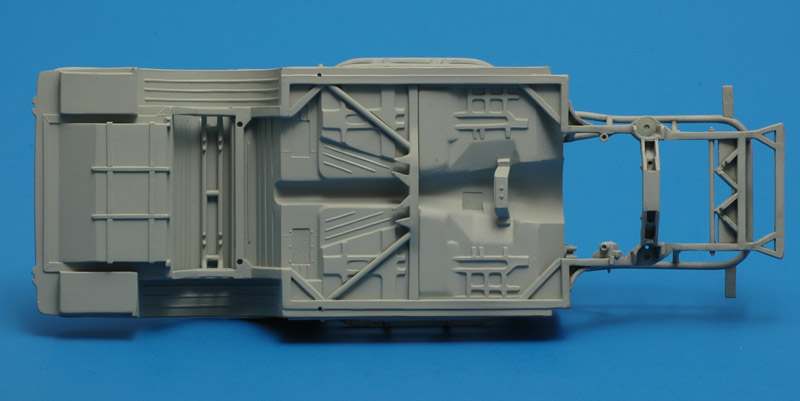
| The lower side of the chassis has the gearbox crossbeam (cut from part 27), the rear suspension crossbeam (part of part 19) and the shock absorber 'bridge' (part 57) installed. I split the rear suspension parts to be able to build and paint the chassis first. I added two transverse straps on the lower side of the fuel tank, copying the layout on the top side of the tank. The lower side of the chassis is not weathered yet.
|
| Here the remaining part of the rear suspension is installed provisionally. I'm also fiddling with the brake calipers.
| 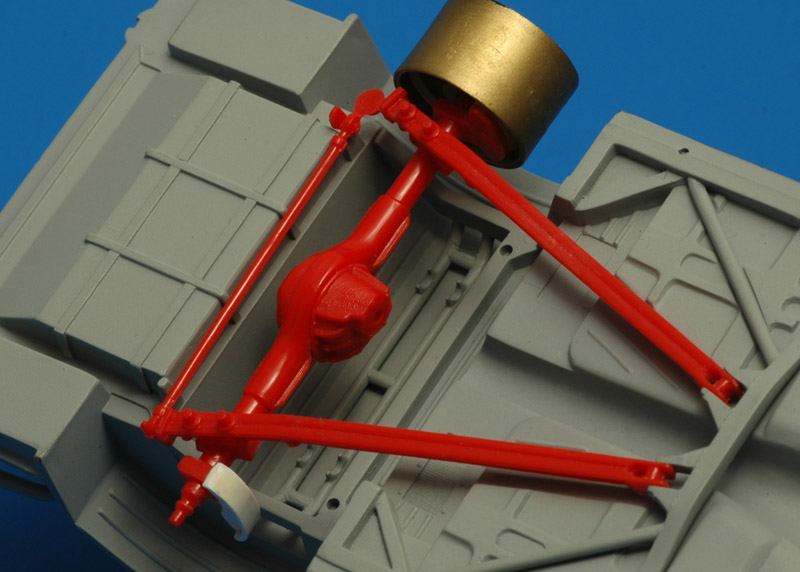
|
Body construction
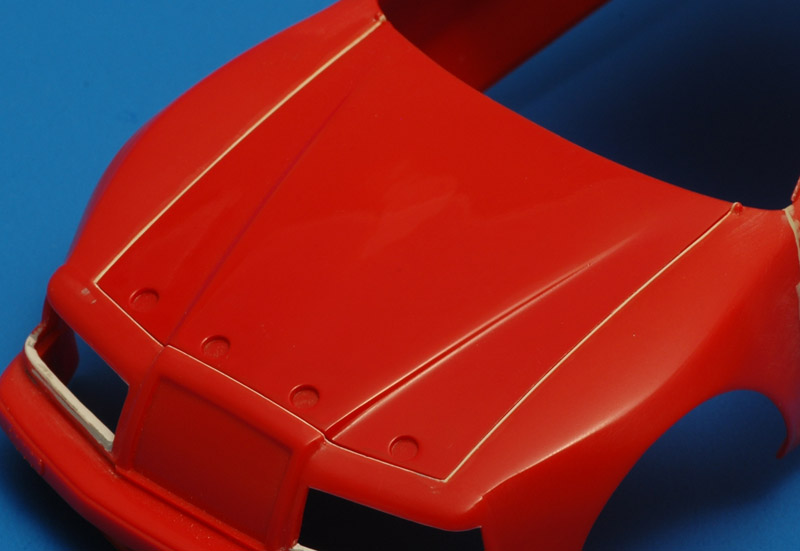
| Over to the body. I glued thin plastic card all around the hood to make it fit tightly. I thinned the edges of the fenders from the inside to make them look like thin sheet metal. As an experiment, I painted the hood with Humbrol 19 and polished it with Tamiya Polish. That worked pretty well, but I went through the paint in the middle of the hood. The Humbrol paint matches the plastic color amazingly well.
Not shown here is that some mold parting lines on the roof and trunk had to be removed. Also I engraved the panel line of the trunk lid on the rear panel, to match it with the depth and width of the panel line on the top side of trunk.
|
| I glued pieces of rod on the inside of the hood, to replicate the light framework of the hood. The thick kit part spoils the impression a bit though.
| 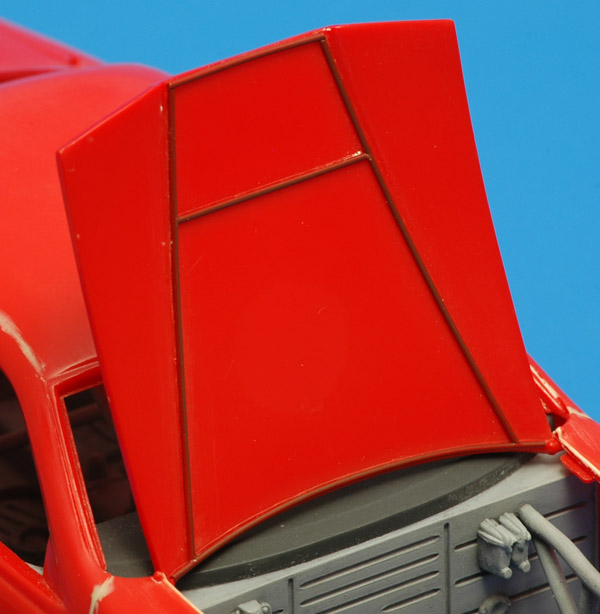
|
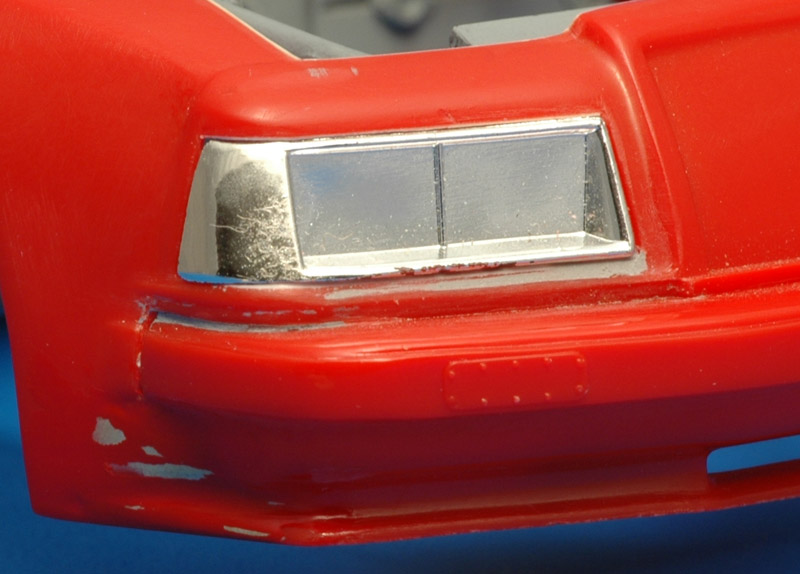
| The fit of the headlights is loose too, so I also added shims beneath the headlights. But maybe they now sit too high? I keep reading that the headlights are not correct for the 1984 and 1985 seasons, but I haven't seen a photo yet that shows what's wrong.
|
| I reshaped the forward part of the front fenders. On the model the bottom curves inwards just like the door panel does. In reality it runs almost straight down, offering more 'coverage' for the front wheels. I used a small hair dryer to soften the plastic, and bent it gently into shape. Some Milliput smoothened the transition from the air dam to the flaired fender. I like the modification a lot: it makes the car look more aggresive.
| 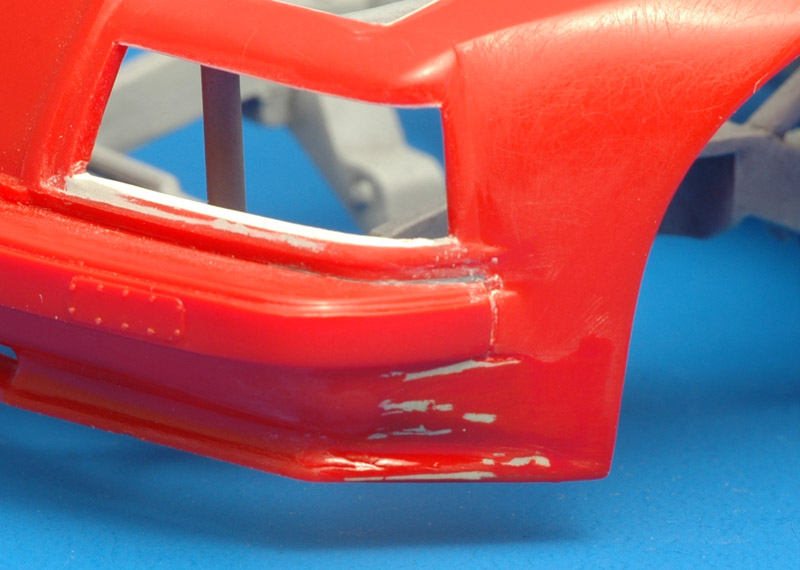
|
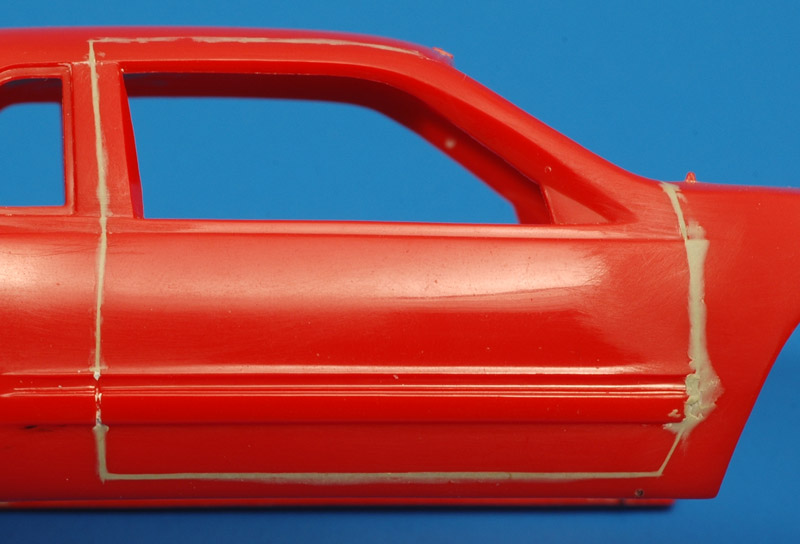
| A difficult modification is the removal of a rubber strip on the doors, an error that Patt Campbell brought to my attention. The street version of the T-Bird has a wide rubber strip running along the door, just below the 'slot' in the sheet metal. Monogram put it also on the NASCAR model, which definitely lacks them.
A difficult choice was whether the door panel lines should be filled or not. I had only a few photographs to base the decision on, and they appear not to show any lines. When I read that most teams were filling the door panel lines by then, I decided to do it too. I used Milliput for the job, and it's clearly not finished yet.
|
| Removing the rubber strip is a delicate operation though, and you need to retain the small fold in the sheet metal just above it. On the left door I did 90% of the removal job. I made some 'contact damage' on the left side, consisting of impressions of another car's wheel. But I reconsidered later, and filled it in again.
| 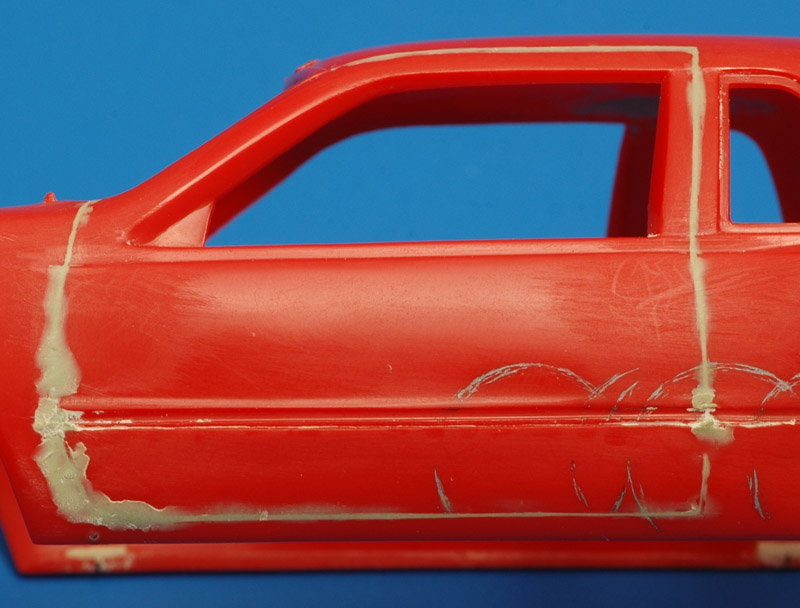
|
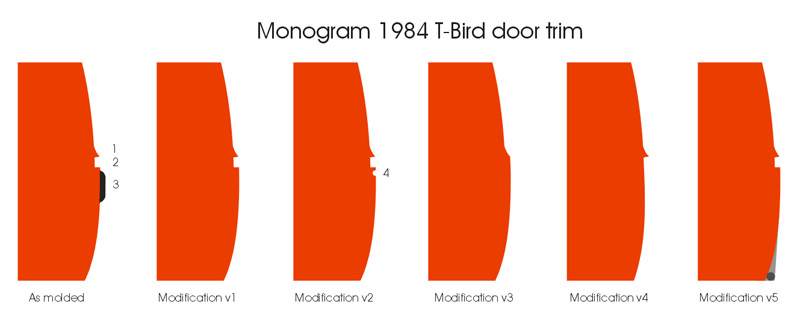
| I still wasn't sure my door is correct, so I made a drawing. I first removed the 'rubber' molding (3), which left me with a different shape than expected: the lower side of the door was now flush with the ridge (1), and there's a recessed area (2). I then added an engraved line (4), that I thought I saw in the street version of the Thunderbird. But I'm not so sure now. Maybe it should like version 3? Or maybe like version 4? In the end I went for version 5, via version 4. In version 5 the lower side of the door is more vertical and less rounded.
|
| I glued a 0.75 mm steel wire to the bottom of the body sides, and built up the area with Apoxie. After two rounds of filling and sanding the body was smooth again. I will probably paint it red to see how the body sides now look, and whether they needs more modifications.
| 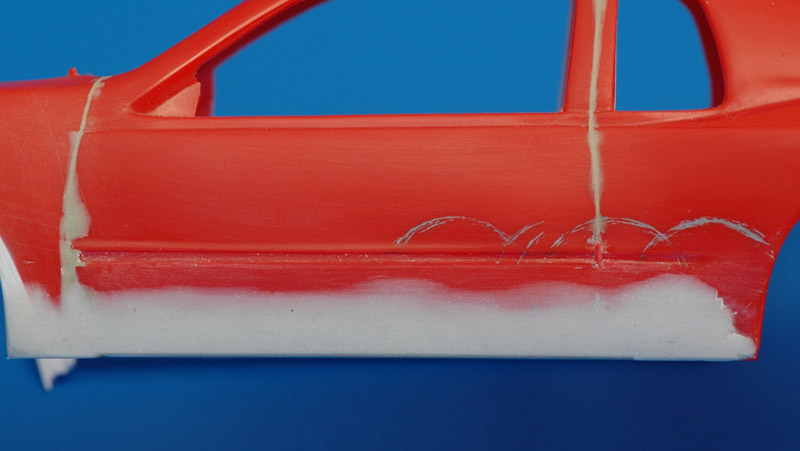
|
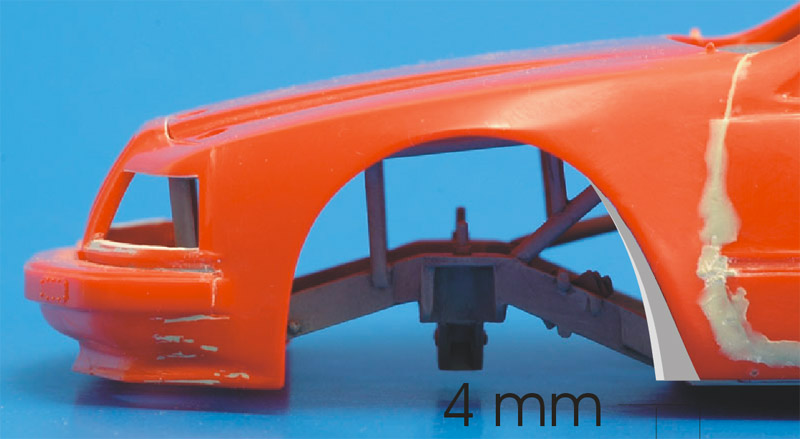
| Everyone agrees that the front wheel opening should be made smaller. I sketched the modification in two versions to see how much plastic should be added roughly, and noted it was around 4 mm.
|
| I superglued eight Evergreen strips of 1.0 x 0.5 mm to the rear side of the front wheel opening, then soaked them in more superglue to bond everything solidly together.
| 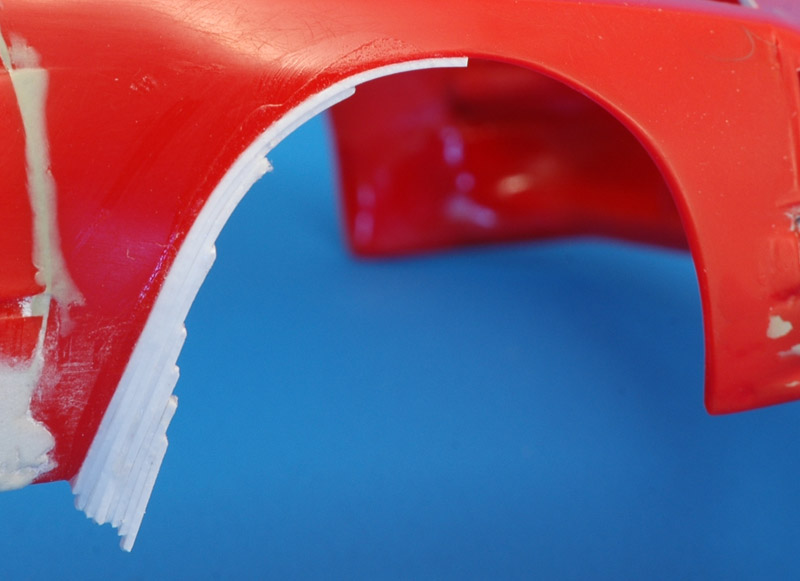
|
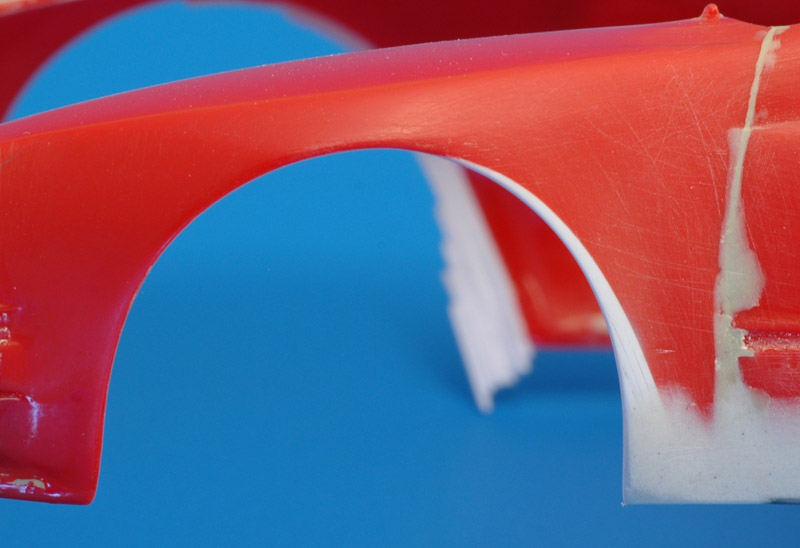
| I used my low-rpm Foredom tool to create a nice curve. It's free-style, and a bit different compared to the drawing I made earlier. While motortooling I also changed the shape of the rear half of the fender. Using a sanding drum I made it concave instead of straight, making it fit smoothly with the door instead of with a kink.
|
| Compared to photos of the real car, the bottom edge of the door window was too narrow, and I added a 1.5 mm plastic strip. At the same time I added a similar strip to the B-pillar, after sanding away the chamfer on the forward face. The rear side of the B-pillar got a similar strip, but most of that had to be cut away again to make the roll cage fit. Lastly, I sanded away the strange chamfer on the A-pillar, which created a thinner A-pillar, following photos of the real thing. I still have to modify the front corner, where the mirror would attach on a street car.
| 
|
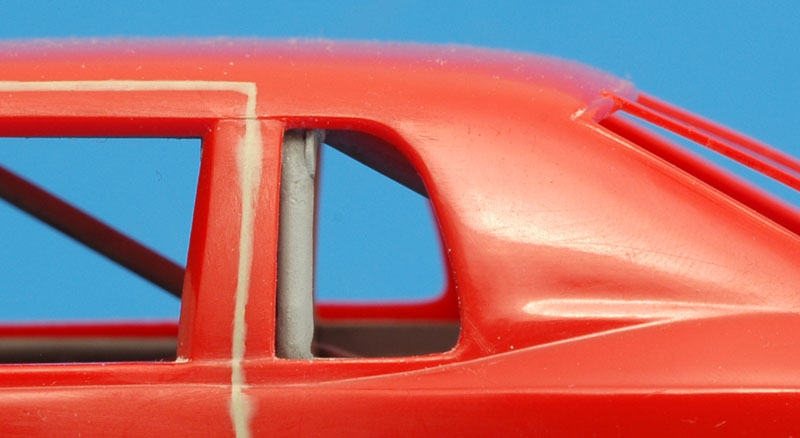
| In the 1984 and 1985 seasons, rear side windows were not used, and therefore the flange should be removed. It was an easy modification, but it made it obvious that the main hoop is located too far aft. It's far too late to do anything about it. Maybe if you start fresh you can move it forward 4 millimeters.
|
| In one of the 1985 Daytona photos, I noted that the the front fender's width was identical to the door width, i.e. the fender did not stick out. The rear fender seemed to exceed the door width slightly in the same photo. With a simple set-up I measured how far the fenders stick out compared to the door area. I could fit two pieces of 1 mm plastic card between the door and the bar, so it's 2 mm. That could mean that 2 mm needs to be removed from the front fender, and maybe 1-1.5 mm from the rear fender.
| 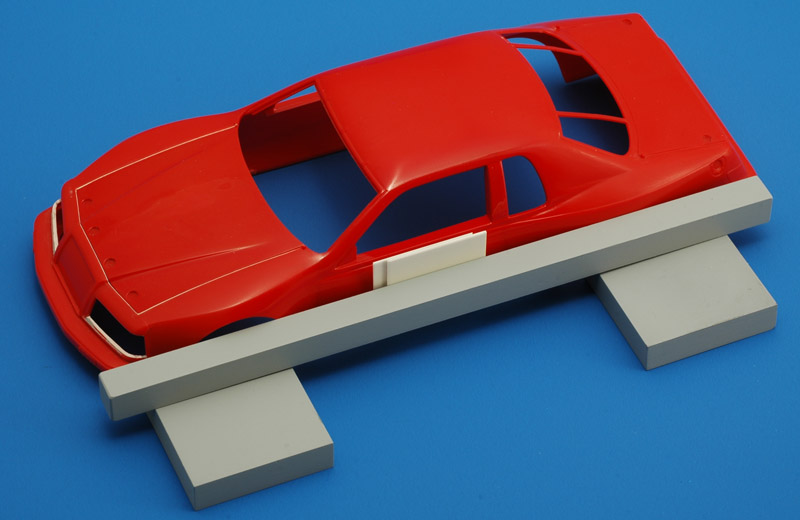
|
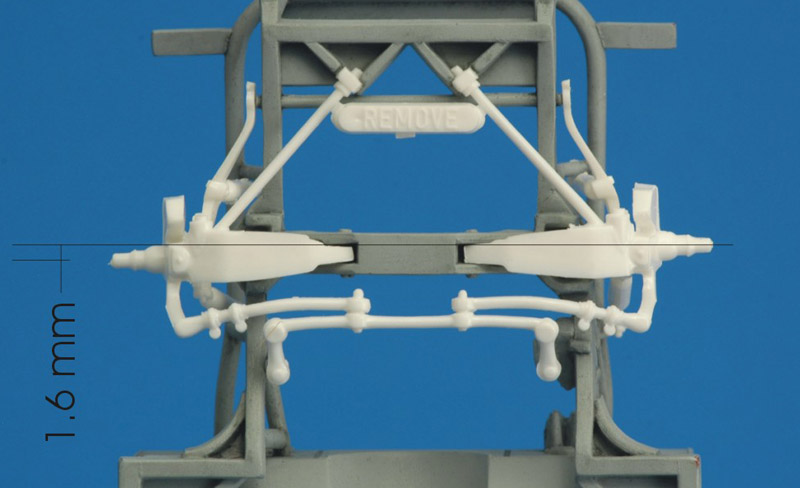
| With the parts from a second kit, I built a 'dummy' assembly of the front suspension for test fitting. And quickly I noticed that the front wheels are staggered, the left wheel being forward at least 1 mm. I tried to measure the difference from the front and found 2.2 mm, and measured it from the back and found 1.2 mm, so I guess the truth is roughly in the middle, around 1.7 mm. I don't want to go overboard on small differences, but this confuses the wheelbase measurement considerably. Also because the rear axle position is a bit undefined too, the cross member with the trailing arms can be positioned with another millimeter of play. Let's sort this out before passing judgement on the wheelbase.
|
Wheels and tires
Monogram supplies five-spoke wheels, whereas the real car had nine-spoke wheels. It seems Monogram put 5-spoke wheels in all Ford kits, and 9-spoke wheels in all others (Buick, Oldsmobile, Pontiac and Chevrolet). Reportedly they are both Norris wheels, but they could be Bassett wheels too. I did not have one of the latter, but fellow IPMS-NL modeler Martin Letterman kindly pulled a wheel of one of his models to allow me to make resin copies. I decided it would be a huge improvement to have open spokes. I disassembled the two-part donor wheel, and made two resin copies of the outer part in a silicone rubber mould. One of them I ground back until the spokes were open, and the other I drilled the center out. After some test fitting I glued them back together, and puttied the seam. In the photo below, this new master is the second wheel from the right. Painted copies are on the left (a Humbrol Polished Steel one, and a Model Master Metalizer Stainless Steel one), and a black resin copy on the right.
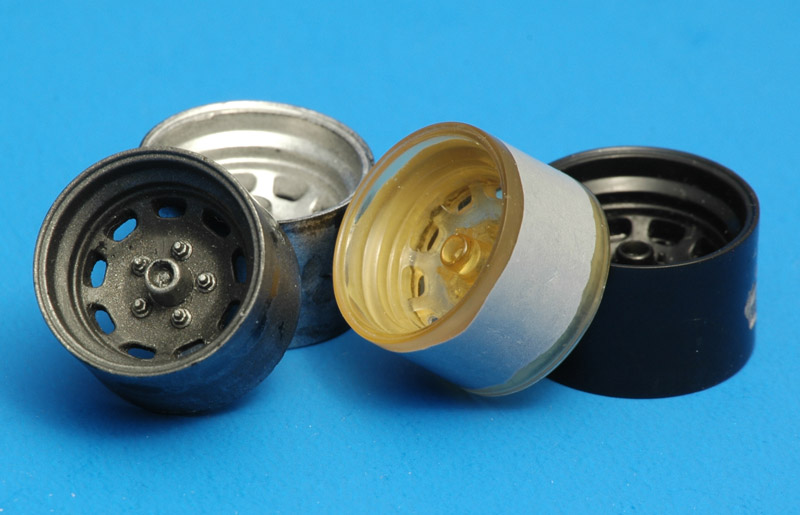
| Then I found out that the original nine-spoke wheel is slightly smaller (17.5 instead of 17.7 mm) than the old five-spoke wheel. This meant that the tyre was a loose fit (you can fit two layers of paper between the wheel and tire), and it showed. I decided to try a new trick to solve that problem. I had figured out that the very different coefficients of thermal expansion of silicone rubber and epoxy offered possibilities for both enlarging and reducing parts. If the resin is left to cure in a hot mould, it will become larger, because the mould has expanded a lot, and the part will shrink much less during cool-down. Rough calculations showed that a 60 degrees Celsius temperature increase gives a 1% larger part. I needed slightly more than 1 percent, so I tried 80 degrees first. The size increase was less than expected though, and in the end I needed a 120 degrees Celsius cure to get the desired size.
|
| Once I had a correctly sized new wheel, I made a one-part mold for the wheel. The open spokes were closed with Kristal Klear which forms a very thin skin. The mold was pretty extreme in terms of undercuts, but since it was a soft rubber type, the castings came out easily. Another lesson learned about the possibilities of resin casting. The photo shows on the left two fresh castings with the pouring stubs still attached, and three trimmed castings on the right.
| 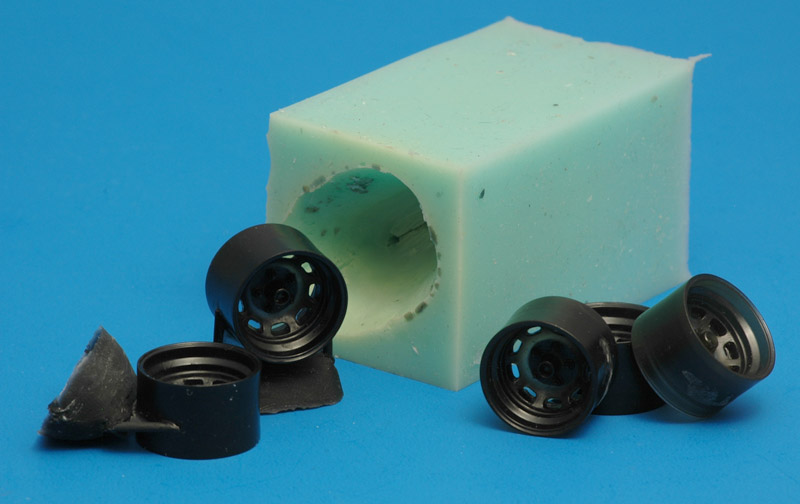
|
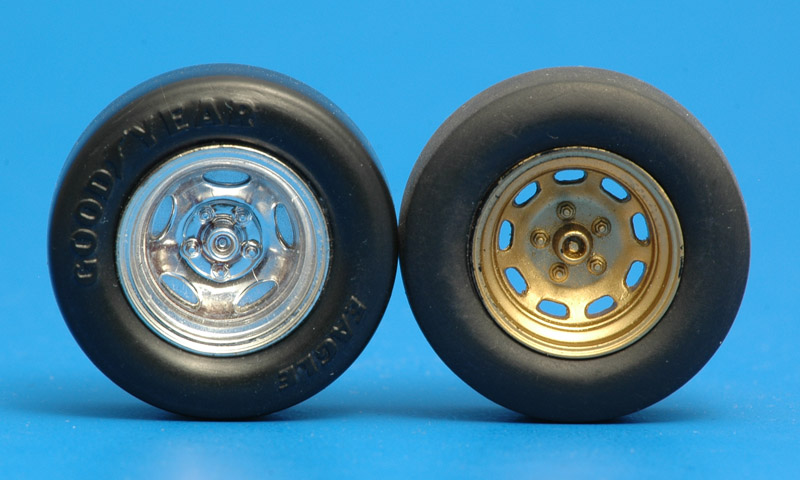
| Here's a comparison of the orginal wheel/tire set and my modified set. The Elliott car had gold wheels. I tried Tamiya enamel gold, and its looks very good. I still need to do some detail painting of the wheel, like the nuts, and an air valve needs to be added.
|
| The brake disc was cut out of the original rear wheel part, and also copied. Six cast epoxy brake discs are shown.
| 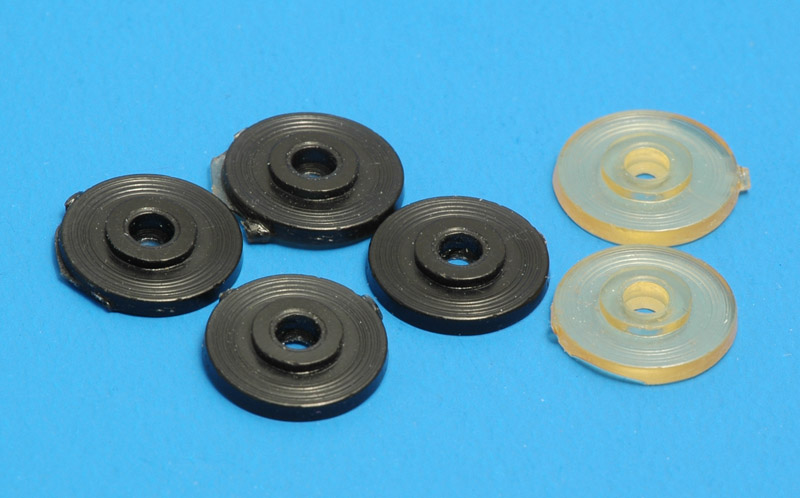
|
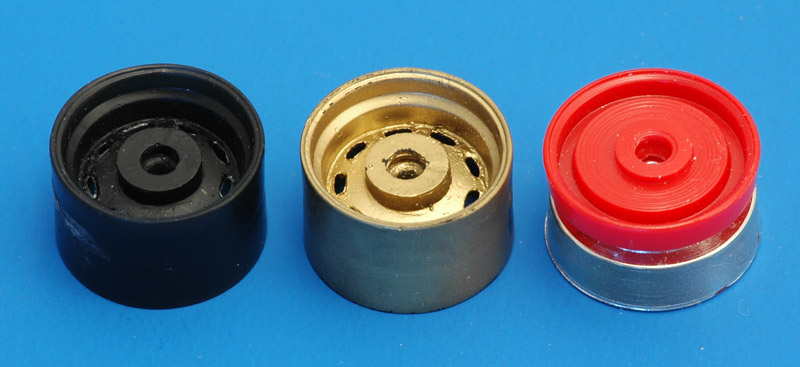
| On the inboard side of the resin wheels, there's a 2 mm boss to which the disc attaches, to recreate the disc position of the plastic kit wheel. Interestingly, I could remove part of the boss to reduce the track of the model, something that the Elliott team possibly did too.
|
Interim result
| The result so far. About halfway I think?
| 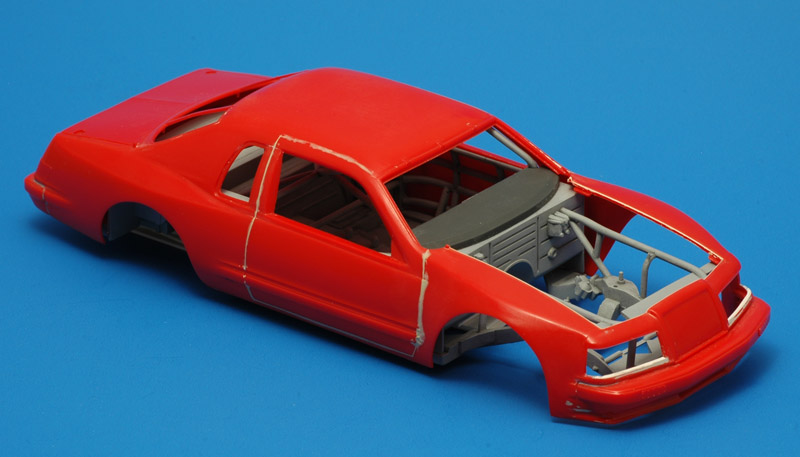
|
Details planned for the future:
using aftermarket decals for the body
adding a small air scoop in the door
making a window net draping over the side (possibly from T-shirt label fabric)
removing the raised 'Goodyear Eagle' lettering on the tyres and replacing them with dry transfers
removing the safety bars moulded integral with the windshield
adding a tinted bar at the top of the windshield
improving the spoiler on the trunk
possibly changing the split exhaust pipes to a double one on the left
turning the front wheels to make the car a bit more lively
Colors
Tamiya TS-8 is reported here as a suitable red color.
Decals
I bought an aftermarket decal sheet by RaceScale and the quality is excellent. I've been told that there is one small problem with that sheet: a red Coors decal for the TV-panel (the back of the car) is missing.
Modeling links
Return to scale models page

































